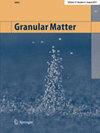滚动摩擦和赫兹的接触模型:从倾斜轨道实验的近似
IF 2.9
3区 工程技术
引用次数: 0
摘要
介绍了一种测量球体在倾斜双缸轨道上滚动摩擦系数的方法。估计的滚动摩擦系数与接触区域的等效变形半径相关,这可以从赫兹接触模型中利用杨氏模量和泊松系数的可用值计算得到。先前文献中确定的滚动摩擦系数值和本文中获得的在钢质双缸轨道上运动的钢球的滚动摩擦系数值表明,钢球半径的变化与接触模型的预期一致。研究了从纯滚动到滚动加滑动的过渡。本文章由计算机程序翻译,如有差异,请以英文原文为准。
Rolling friction and Hertz’s contact model: an approximation from inclined track experiments
A method to measure rolling friction coefficients for spheres rolling down an inclined two-cylinder track is described. The estimated coefficients of rolling friction are correlated with the equivalent radius of the deformation in the contact region, which can be calculated from Hertz’s contact model using available values of Young’s modulus and Poisson’s coefficient. The values of the coefficients of rolling friction determined in prior literature and those obtained here for steel spheres moving on a steel two-cylinder track show a variation in the sphere radius consistent with that expected from the contact model. The transition from pure rolling to rolling plus sliding regimes is also studied.
求助全文
通过发布文献求助,成功后即可免费获取论文全文。
去求助
来源期刊

Granular Matter
MATERIALS SCIENCE, MULTIDISCIPLINARY-MECHANICS
CiteScore
4.30
自引率
8.30%
发文量
95
期刊介绍:
Although many phenomena observed in granular materials are still not yet fully understood, important contributions have been made to further our understanding using modern tools from statistical mechanics, micro-mechanics, and computational science.
These modern tools apply to disordered systems, phase transitions, instabilities or intermittent behavior and the performance of discrete particle simulations.
>> Until now, however, many of these results were only to be found scattered throughout the literature. Physicists are often unaware of the theories and results published by engineers or other fields - and vice versa.
The journal Granular Matter thus serves as an interdisciplinary platform of communication among researchers of various disciplines who are involved in the basic research on granular media. It helps to establish a common language and gather articles under one single roof that up to now have been spread over many journals in a variety of fields. Notwithstanding, highly applied or technical work is beyond the scope of this journal.
 求助内容:
求助内容: 应助结果提醒方式:
应助结果提醒方式:


